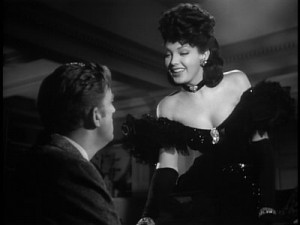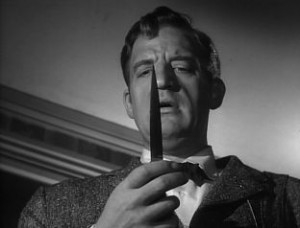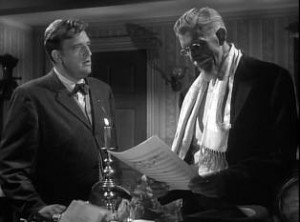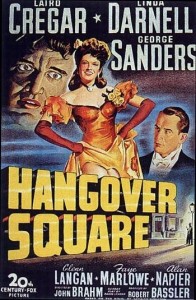PASSION, OBSESSION, INSANITY AND MURDER!
Laird Cregar, a name not all that familiar today, tried his hardest to be a versatile actor, tackling comedy (Heaven Can Wait as the Devil, Charley’s Aunt), film noir (This Gun for Hire), swashbucklers (The Black Swan, as privateer Sir Henry Morgan), historical adventures (Blood and Sand, Hudson’s Bay), even a musical (Hello Frisco, Hello), but the most frequent genre represented in his small oeuvre is the one with which he is, now, most associated—horror and mystery: The Lodger, I Wake Up Screaming . . . and Hangover Square.
Although he received top billing only in this last, he was always, it seemed, if not “opposite” as such, at least in the same picture with, big-name stars: Tyrone Power, Merle Oberon, Alice Faye, Henry Fonda, Betty Grable and Alan Ladd, and more than once with Maureen O’Hara, Gene Tierney and George Sanders.
So what happened? Many things worked against Cregar’s ambitions for versatility and better roles. First of all, and immediately obvious on screen, he is an enormous man, not exactly “fat,” at a one-time weight of 300 pounds, but tall and large, big-boned as they say. Off screen, he could be charming and funny, but he had a split personality, much like the character he plays in Hangover Square. Part of this duality came from the need to tightly closet his homosexuality, at a time when the subject was not, as sometimes today, flagrantly exhibited. And, most tragic of all, he died young, age thirty-one, from a heart attack following a stomach operation, almost two months before the release of Hangover Square.
 The major stars sharing Hangover Square with Cregar are Linda Darnell, George Sanders and a then seventeen-year-old Faye Marlowe. This was the first of only nine films, and she is still alive at this writing. Surprisingly uncredited but otherwise falling about seventh in the cast listing is Michael Dyne, better known later as a Tony-nominated writer for television.
The major stars sharing Hangover Square with Cregar are Linda Darnell, George Sanders and a then seventeen-year-old Faye Marlowe. This was the first of only nine films, and she is still alive at this writing. Surprisingly uncredited but otherwise falling about seventh in the cast listing is Michael Dyne, better known later as a Tony-nominated writer for television.
The minor players feature Glenn Langan (a better role would be his the next year in Dragonwyck) and a host of those Brits that populate so many Hollywood films of the era—Alan Napier (Tippi Hedren’s father in Marnie, the university dean in Journey to the Center of the Earth), Frederick Worlock (veteran of six Rathbone/Sherlock Holmes movies for Universal) and Clifford Brooke (Tuttle in The Sea Hawk, David Lloyd George in Wilson). There are other Brits—Leslie Sketchley, Jimmy Aubrey, Leyland Hodgson, John Rogers and Charles Irwin—and a few Australians for good measure.
 In 1903 London, George Harvey Bone (Cregar) stabs an antique dealer and sets fire to his shop—fire to be a refrain in the film, with composer Bernard Herrmann even creating a “fire” motif. When Bone reads about a murder and fire in Fulham Road and realizes there’s a gap in his recent memory, he wonders if he might be responsible. After checking the evidence, a psychiatrist of sorts, Dr. Middleton (Sanders) at Scotland Yard, assures him there is no connection, though it doesn’t entirely clear him, either. (At least one other film murder occurs in Fulham Road, London. Remember the asphyxiation of the typist in The List of Adrian Messenger?)
In 1903 London, George Harvey Bone (Cregar) stabs an antique dealer and sets fire to his shop—fire to be a refrain in the film, with composer Bernard Herrmann even creating a “fire” motif. When Bone reads about a murder and fire in Fulham Road and realizes there’s a gap in his recent memory, he wonders if he might be responsible. After checking the evidence, a psychiatrist of sorts, Dr. Middleton (Sanders) at Scotland Yard, assures him there is no connection, though it doesn’t entirely clear him, either. (At least one other film murder occurs in Fulham Road, London. Remember the asphyxiation of the typist in The List of Adrian Messenger?)
In another scene, Bone is gentle and easy-going, a serious composer working on a piano concerto. He’s sincerely humbled when conductor Sir Henry Chapman (Napier) suggests that he might present the work at a Philharmonic concert. Bone is courting Sir Henry’s daughter Barbara (Marlowe).
Middleton theorizes that Bone’s lost of memory might be due to stress from his composing and suggests that he get out with “ordinary, everyday people.” Bone attends a tawdry music hall and meets singer/dancer Netta (Darnell). Playing up to the composer, she pleads for a song. As Herrmann would have said—and did, in no uncertain terms when Hitchcock wanted a pop song for Torn Curtain—Bone responds,“I don’t write that kind of music.”
 Bone easily succumbs to Netta’s charms and turns out a waltz tune, “All for You.” In even this pre-Torn Curtain time, although Herrmann “didn’t write that kind of music”and the tune is credited to Lionel Newman (lyrics by Charles Henderson), he certainly wrote it, as the melody appears in the concerto. With the flattering help of her friend Mickey (Dyne), Netta secures more songs from the troubled composer, diverting his attention from the concerto.
Bone easily succumbs to Netta’s charms and turns out a waltz tune, “All for You.” In even this pre-Torn Curtain time, although Herrmann “didn’t write that kind of music”and the tune is credited to Lionel Newman (lyrics by Charles Henderson), he certainly wrote it, as the melody appears in the concerto. With the flattering help of her friend Mickey (Dyne), Netta secures more songs from the troubled composer, diverting his attention from the concerto.
Outside his flat, where the gas company is laying pipe, a passing wagon spills its load of pipe as Bone is walking by. For a sensitive composer like Bone, the metallic clatter—a definite dissonance—sends him into a catatonic daze, symbolized in Herrmann’s orchestra by three piccolos and muted horns. For some reason not made clear, Bone tries to strangle Barbara. The frantic search music, with London bobbies dashing about, recalls the “Death Hunt” sequence Herrmann would write in 1952 for On Dangerous Ground.
Bone later finds that Netta has been avoiding him, then that she’s engaged (to Langan). Upset, he tosses one of her music hall posters into a rack of violins which clatter to the floor. The noise triggers another traumatic episode. Bone retrieves the same curtain sash he used on Barbara and seeks out Netta, and during a Guy Fawkes Day celebration, he places her body, disguised as a masked dummy, atop a bonfire.
The climax of the film is the premiere of Bone’s concerto, known subsequently as the Concerto Macabre. It opens with a quasi-Lisztian solo for the piano. Netta’s waltz, “All for Love,”now clothed in classical lines, follows, and during the demonic middle section Bone hallucinates, seeing all his crimes in swirling flashbacks. Here Herrmann incorporates into the concerto the music heard during the film. And too traumatized to continue, Bone allows Barbara to take his place at the piano.
When the police try to take him away, he throws a lamp at them. In the ensuing fire, the orchestral musicians flee and Middleton rushes Barbara to safety. Bone, alone at the piano, finishes the concerto, which, just by coincidence, he had written for piano solo. The screen fades out, Bone lost amid engulfing flames and smoke.

CFF, bravo for your detailed, compelling review of HANGOVER SQUARE, a film that’s always resonated with me. It may be a bit flawed, but Laird Cregar’s performance blends madness and poignancy very well, and makes me sad that he died so young and so senselessly. At the very last, it’s certainly an object lesson in why it’s unwise to go to drastic means for your art. HANGOVER SQUARE’s brooding, Victorian-inspired atmosphere strikes me as a sort of retro-noir. Great post!
Well done review. After reading so many poorly written posts by other so-called critics it is a pleasure to read one with depth and insight like yours. Thank you.